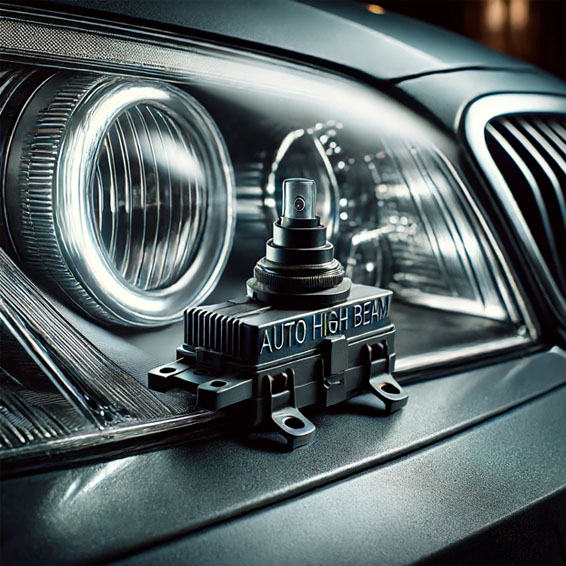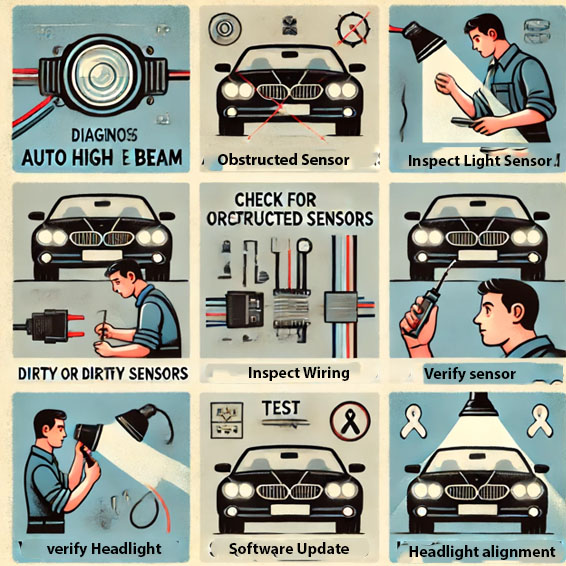before Discuss Auto High Beam problem we need to know about it. Auto high beams are a sophisticated driver assistance feature that boosts nighttime visibility and enhances safety. These systems automatically adjust your headlights from high to low beam when they detect oncoming traffic, preventing you from blinding other drivers. Despite their innovative design, many drivers need help with these systems, leading to frustration and potential safety hazards.
Common Auto High Beam Problem
Misalignment of Sensors

One major cause of auto high beam malfunction is misaligned sensors. These sensors detect ambient light and oncoming vehicles, but they need to switch the beams correctly to be properly calibrated.
Dirty or Obstructed Sensors

Dirt, snow, or other obstructions can cover the sensors, preventing them from detecting light accurately. It can lead to the system failing to recognize oncoming traffic, resulting in improper high-beam usage.
Software Glitches
Software issues can significantly affect the performance of auto high beams. The software controlling this feature may sometimes have bugs or need updates to function correctly.
Electrical Problems
Electrical issues within the car’s wiring or the headlight system can cause failures in the auto high beam feature. Faulty wiring or poor connections might prevent the system from receiving the signals it needs.
Environmental Factors
Adverse weather conditions like heavy rain, fog, or snow can interfere with the sensors’ ability to detect other vehicles, making the auto high beams act unpredictably.
How to Diagnose Auto High Beam Problems

Check for Sensor Obstructions
Regularly inspect the sensors for dirt or debris. Cleaning sensors often resolves simple detection issues. Make sure the area around the sensors is clear and unobstructed.
Software Updates
Ensure your vehicle’s software is up-to-date. Manufacturers often release updates to fix bugs and improve functionality. Check your car’s manual or contact the dealer for information on software updates.
Consult the User Manual
Your car’s user manual provides specific troubleshooting steps tailored to your vehicle model. Follow the guidelines for calibrating and resetting the auto high beam system.
Professional Diagnostics
If basic troubleshooting doesn’t resolve the issue, consider taking your vehicle to a professional mechanic. They have the tools and expertise to diagnose and fix complex electrical or software problems.
Preventive Measures for Auto High Beam Problems
Regular Maintenance
Follow your vehicle’s maintenance schedule. Regular check-ups can help identify potential issues before they become significant problems.
Clean Your Car Regularly
Regularly washing your car, especially around the sensors, can prevent dirt and debris buildup and ensure the sensors work correctly.
Software Maintenance
Stay informed about software updates from your vehicle’s manufacturer. Keeping your car’s software current can prevent many issues related to auto high beams.
Understand Environmental Impacts
Be aware of how weather conditions affect your vehicle’s sensors and auto high beam performance. Drive cautiously in adverse weather and consider manually controlling your headlights in such situations.
When to Seek Professional Help
Persistent Issues
If your auto high beam problem persists despite following troubleshooting steps, it’s time to consult a professional. Persistent issues often indicate more profound, complex problems requiring expert attention.
Complex Electrical Problems
Electrical issues can be tricky and dangerous without proper knowledge and tools. A professional mechanic can safely diagnose and fix these problems.
Manufacturer Recalls
Auto-high beam issues may sometimes be part of a more extensive recall. Check with your vehicle manufacturer or dealership to see if there are any recalls or known issues related to your car model.
The Importance of Auto High Beam Functionality
Enhanced Nighttime Visibility
Properly functioning auto high beams significantly improve nighttime visibility, making driving safer for you and other road users.
Driver Convenience
Auto high beams relieve drivers from constantly switching between high and low beams, allowing them to focus more on the road.
Road Safety
The system enhances overall road safety by preventing high beam glare from affecting oncoming drivers, reducing the risk of accidents.
The Future of Auto High Beams
Advancements in Sensor Technology
Future advancements in sensor technology will likely improve the reliability and accuracy of auto high beams, making them more effective in various driving conditions.
Integration with Other Systems
Integration with other advanced driver assistance systems (ADAS) can enhance the functionality of auto high beams. For instance, combining lane-keeping assistance and adaptive cruise control could provide a more comprehensive safety solution.
Enhanced AI Algorithms
Artificial intelligence can refine the algorithms that control auto high beams, resulting in more precise and responsive adjustments, further enhancing safety and convenience.
Conclusion
Auto high beams are a valuable feature that enhances driving safety and convenience. However, like any advanced system, they can encounter problems. Understanding common issues, how to diagnose and fix them, and when to seek professional help can keep your auto high beams functioning correctly. Regular maintenance, updating software, and being aware of environmental impacts are key to ensuring this feature continues to benefit you and other road users.
By addressing auto high beam problems promptly and efficiently, you can maintain optimal visibility on the road, contributing to safer driving experiences for everyone. Whether it’s a minor sensor misalignment or a complex software glitch, taking proactive steps can prevent minor issues from escalating into significant problems.
FAQs
What should I do if my auto high beams are not working correctly?
Start by checking for obstructions on the sensors and ensuring they are clean. Then, check if your vehicle’s software needs an update. If the problem persists, consult your vehicle’s user manual or take your car to a professional mechanic.
Can weather conditions affect auto high beam functionality?
Adverse weather conditions like heavy rain, fog, or snow can interfere with the sensors’ ability to detect oncoming vehicles, causing the auto high beams to malfunction.
How often should I clean the sensors for auto high beams?
It’s a good practice to clean the sensors regularly, especially after driving in muddy or snowy conditions. Regular cleaning helps ensure the sensors function correctly.
Are software updates important for auto high beam systems?
Absolutely. Software updates can fix bugs and improve the overall functionality of the auto high beam system. Always ensure your vehicle’s software is up-to-date.
Can I manually control the high beams if the auto system fails?
Yes, most vehicles with auto high beam features still allow manual control of the headlights. Refer to your vehicle’s user manual for instructions on switching between automatic and manual modes.
Is it expensive to repair auto high beam systems?
The cost of repairs can vary depending on the issue. Simple sensor cleaning or software updates may be inexpensive, while complex electrical or software problems might cost more. Consulting with a professional mechanic can give you a better idea of the potential costs.

